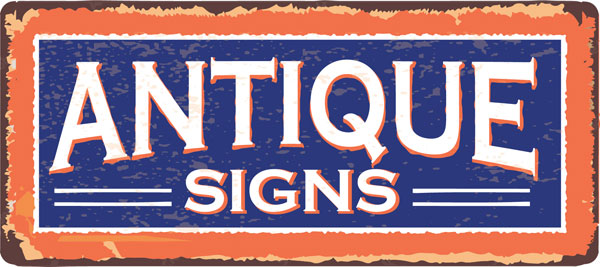It’s easy to see why vintage enamel signs have caught the eye of collectors, investors and retro enthusiasts alike.
Works of art, lucrative investment opportunities, slices of history – vintage enamel signs are all these and more. With a popularity fuelled by antique reality shows and a thriving global market, there’s never been a better time to explore the stylish and rewarding world of vintage signs.
Whether you’re looking for a vibrant addition to your home décor or a stake in an emerging market, an antique enamel sign collection can enrich your life – in more ways than one.
Here’s everything you need to know to get started.
What are enamel signs?
Enamel signs are an older style of advertising that became popular in the late 1800s.
They were made by fusing layers of powdered glass, one by one, onto a metal base at high temperatures, giving them their characteristic raised appearance.
Glossy, eye-catching and very durable, they were the perfect advertising medium in a time when not many people could read. Their colourful and recognisable designs grabbed the attention of passersby, and they were tough enough to handle any weather conditions.
First created in Europe, enamel signs soon gained wider popularity in England before spreading to the US and Australia as businesses realised their potential. They soon adorned walls, doors and storefronts across the globe.
Unfortunately, due to metal shortages caused by the two world wars, a great many enamel signs were melted down for their metal bases.
While this set back enamel sign production in Europe, a booming post-war US enthusiastically embraced their glossy allure, producing much of the iconic signage that remains popular even today.
Eventually though, faced with cheaper advertising alternatives such as television and plastic, enamel signs fell out of favour – until nostalgic collectors drew their retro charms back into the spotlight.
Why are enamel signs so popular?
The growing appetite for vintage signs is not limited to retro enthusiasts.
Naturally, their aesthetic appeal is a big draw. Designed by skilled artists and professional craftsmen, enamel signs come in a dazzling array of colours, shapes and sizes. Combine that with their glossy façade and unique raised-surface appearance, and you have a timeless retro décor for any home or workplace.
The classic stylings of an enamel sign also represent a piece of history.
Each sign is a slice out of the last 150 years – an enduring glimpse into a different time. For some, they’re a cosy reminder of the good old days. For others, they’re an important remnant of a distant era. Historians, collectors and the nostalgic alike are drawn to these signs of the times.
More recently, the soaring demand for enamel signs has seen an influx of investors who are interested in their potential for profit.
Only a decade or two ago, signs were readily bought and sold for hundreds of dollars. Now, rare mint-condition signs can go for up to $US1.5 million!
What makes a sign valuable?
Of course, not every sign is an artistic masterpiece or a financial jackpot. Many signs are quite ordinary – common, damaged or not particularly appealing.
There are several qualities that can affect the value of a vintage sign, and knowing the general rules can give you a good idea of what a sign is worth.
Here are some of the most important factors.
Condition
Like any collectible, the condition of a sign is extremely important. An enamel sign in near-perfect condition can be worth tens or hundreds of times more than a damaged sign.
Rarity
The rarer, the better. An uncommon sign will usually fetch a higher price than a common one.
Design
Signs are made to be displayed, so it’s no surprise that more appealing signs command a higher price. Beautiful artwork, interesting shapes and designs, novel colour schemes – a stylish sign will have no shortage of suitors.
Brand
For some collectors, the brand of a vintage enamel sign has a value of its own. An iconic brand or style can make a sign more desirable, particularly to specialist collectors.
Watch out for fakes and restorations
Any lucrative collectible market inevitably attracts some dishonest people trying to fleece the unwary.
You’ll come across replica signs with artificial damage to make them look older, signs that have been restored yet are claimed to be original, and even signs that never actually existed - despite sporting a popular brand!
Most of these fakes are easy to spot, but others are really well made and can fool even a seasoned collector.
Unless you know what you’re doing, stick with reputable and trustworthy sellers. And for any substantial purchase, it’s a good idea to seek professional advice.
Of course, there’s nothing wrong with buying a sign for its appearance alone, but just be aware that only original, untouched signs have any value as collectibles.
Collecting vintage enamel signs can be a fun and potentially profitable hobby. You can liven up your lounge or man cave or even make some extra cash with these timeless pieces of art.

